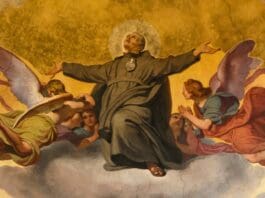
Born Paolo Francesco Danei on January 3, 1694, in the scenic town of Ovada, Piedmont, located in the Duchy of Savoy in northern Italy, Saint Paul of the Cross stands as one of the 18th century’s most eminent Catholic mystics.
Originating from a prosperous merchant lineage, Paul underwent a spiritual awakening at 19, after living an otherwise ordinary, devout life. He was deeply influenced by Saint Francis de Sales’ “Treatise on the Love of God.” His interactions with the Capuchin Order’s priests further instilled in him the importance of divine love and the necessity to transcend our conventional perceptions of God. For Paul, the Passion of Jesus Christ wasn’t just a historical event, but an epitome of God’s boundless love and a pathway to oneness with the Divine. He dedicated his life to spreading this profound message and laid the foundation for a religious community to amplify this cause.
At 26, Paul, through a series of divine visions, felt a call from God to form a religious community dedicated to the teachings and meditation on the Passion of Jesus. In one such vision, he saw himself adorned in a unique black habit, bearing a heart with a white cross, inscribed with “the Passion of Jesus Christ.” A celestial voice told him that this heart symbolized the purity required to carry Jesus’s revered name. Initially known as “the Poor of Jesus,” the community later adopted the name the Passionists.
Endorsed by his bishop, Paul donned the black hermit’s attire and penned the community’s guiding principles in 1720. The community’s ethos centered on living humbly, in seclusion, and enlightening people on the Passion of Jesus.
Paul’s brother, John Baptist, soon joined him, and both were ordained priests in St. Peter’s Basilica, Rome, in 1727. They primarily focused on missionary work, especially in remote areas underserved by priests. Their fervent preaching and spiritual retreats gradually drew more followers, expanding their community.
Though the Passionist’s rigorous way of life wasn’t universally appealing, Paul valued genuine, albeit slow, growth. He envisioned his community as one marked by unwavering dedication to God, apostolic service, deep prayer, and detachment from worldly trappings. The first Passionist monastery, or “retreat” as Paul termed it, was inaugurated in 1737 on Monte Argentario, with nine devoted members. The name “retreat” emphasized the solitude and reflection crucial for those heralding the message of the Cross.
Throughout his life, Paul of the Cross gained renown as a distinguished preacher and spiritual mentor. His extensive correspondence, over two thousand letters, mainly offering spiritual guidance, remains preserved.
On October 18, 1775, he passed away at the Retreat of Saints John and Paul. At his death, the Passionists had grown significantly with twelve retreats and a contemplative nunnery in Corneto, all committed to celebrating the Passion of Jesus through prayer and penance.
Saint Paul of the Cross was beatified in 1852 and canonized by Blessed Pius IX in 1867. His feast day, initially celebrated on April 28, was later shifted to October 20, closer to the anniversary of his demise and the feast of Saint Luke the Evangelist.
Photo credit: Lawrence OP via Flickr
The post Saint Paul of the Cross appeared first on uCatholic.
Daily Reading
Memorial of Saints Basil the Great and Gregory Nazianzen, Bishops and Doctors of the Church
Readings for the Memorial of Saints Basil the Great and Gregory Nazianzen, Bishops and Doctors of the Church Reading 1 1 John 2:22-28 Beloved: Who is the liar? Whoever denies…
Daily Meditation
A Voice in Today’s WildernessUna voz en la jungla de hoy día
Click here for daily readings Today’s Gospel passage is especially relevant as we begin a new year with resolutions and hope. In this reading we hear John’s declaration echoing the…




